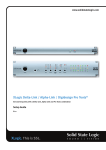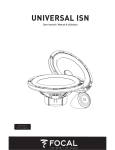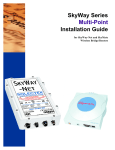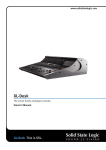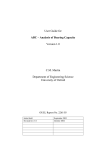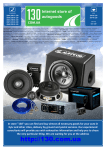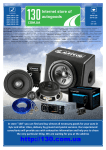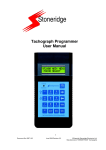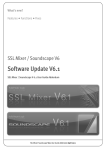Download Focal CMS 40
Transcript
MONITOR BENCHTEST Focal CMS 40 KEITH HOLLAND with grilles to cover the drivers, but these were removed for this test and a supplied ‘phase optimization plug’ was fitted to the front of the tweeter, as per the recommendations in the user manual. The front panel of the speaker houses the two drivers along with a slot port, power button, volume control and power and clip LEDs. The rear panel has switches to change input sensitivity (+4dBu/0/10dBV), LF shelving (below 450Hz) and HF shelving (above 4.5kHz) along with an IEC mains socket and he CMS 40 is the smallest speaker in Focal’s balanced XLR and unbalanced phono input sockets. range of studio monitors, with overall All testing was carried out with the shelve controls set dimensions of only 238mm high by 156mm to 0dB. Focal specifies both power amplifiers as 25W wide by 155mm deep. It is a two-way active RMS giving a single speaker a claimed maximum peak speaker comprising a 4-inch woofer with a Polyglass output of 97dB SPL at 1m distance. cone and a 25mm aluminium/magnesium inverted Figure 1 shows the on-axis frequency response dome tweeter. The power amplifier, crossover and and harmonic distortion for the CMS 40. The response SSL Hybrd Workflow_Jan2011_Layout 1 28/01/2011 14:36 Page 1 protection electronics are all built-in to the cabinet which is seen to be commendably flat, lying between is made of cast aluminium. The speaker is supplied ±3dB limits from 60Hz to 20kHz; however there T Fig. 1. On-axis frequency response and distortion. is evidence of a some resonant behaviour around 600Hz. The low frequency roll-off is 6th-order, indicating the use of a high-pass electronic protection filter, with -10dB at around 48Hz; quite respectable for a speaker of this size. Harmonic distortion levels are also reasonable, with a peak in 2nd harmonic distortion of around -27dB (4·5%) at 100Hz. It should be noted here that the test level of 90dB at a distance of 1m is only 7dB below the claimed maximum output level for this speaker. Off-axis behaviour is shown in Figures 2 and 3 for the horizontal and vertical planes respectively. There is very little mid-range narrowing and the horizontal directivity is well controlled with a gradual fall-off in response with increasing angle and frequency. The vertical directivity shows a deep and wide interference notch around the crossover frequency, in both upward and downward directions, due to the spacing of the drivers; use of these speakers MONITOR BENCHTEST Fig. 2. Horizontal directivity. Fig. 3. Vertical directivity. Fig. 4. Step response. Fig. 5. Power cepstrum. Fig. 6. Acoustic centre. Fig. 7. Waterfall plot. in the horizontal (landscape) orientation would therefore not be recommended. Figure 4 shows the time-domain response of the Focal to a step input. This response demonstrates that there is very good time alignment between the drivers with the high-frequency output responding only about 0.2 milliseconds before the mid frequencies. There is clearly some ringing at low frequencies though. The power cepstrum (Figure 5) shows little sign of echoes or reflections which is borne out by the flat on-axis response noted above. The acoustic source position (Figure 6) shows that the group delay at low frequencies is equivalent to an increased distance of around 3.5m compared to the mid and high frequencies. This is typical of a speaker with a 6th-order roll-off due to the use of a port and a high-pass protection filter. The resonance at about 600Hz noted above can very clearly be seen in the waterfall plot in Figure 7 as a tone that rings after the rest of the response has decayed. However, the low frequencies decay faster than many similarlyspecified speakers. The Focal CMS 40 is a commendable performer. What it lacks in power output it makes up for with a balanced performance in all other aspects. It is not without problems though with the resonance at 600Hz. n www.solidstatelogic.com


